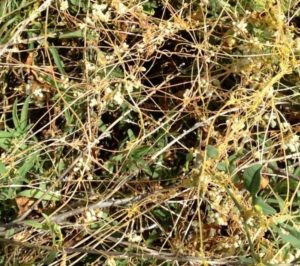Jourdan M. Bell, Agronomist, Texas A&M AgriLife Research and Extension – Amarillo
Peter Dotray, Weed Scientist, Texas A&M AgriLife Research and Extension – Lubbock
Scott Nolte, Weed Scientist, Texas A&M AgriLife Extension – College Station
Muthu Bagavathiannan, Weed Scientist, Texas A&M AgriLife Research – College Station
Dodder (Cuscuta sp.), also commonly known as cuscuta, is a parasitic, leafless, annual weedy vine that is becoming more common across the Texas Panhandle. Dodder has many nicknames, like love vine, witches shoelaces, hairweed, and devilguts. Dodder resembles spaghetti. The vine color ranges from light yellow to golden yellow with white flowers. In recent years, dodder has been reported along right-of ways and in disturbed, low lying areas of native rangelands that collect water in Carson, Hutchinson, Moore, Oldham, and Potter Counties (Jourdan Bell, personal observations); however, there have also been numerous reports of dodder across other regions inTexas.
Dodder reproduces by seeds. It is reported that up to 2,000 seeds/plant can be produced that remain viable in the soil for several years. Seeds can germinate in the soil or on the bark of a host plant. When germinating from the soil, dodder can survive for 10 days, but it must find and attach to another plant or it will die. The plant that dodder attacks is called a host plant. Once it finds a suitable host, it twines around its stem, always in a counterclockwise direction. Dodder will lose its connection to the soil and will no longer have roots. It now completely relies on its host. Since dodder does not produce its own food (sugars from photosynthesis), it survives by stealing resources from its host plant. Once dodder becomes established, it penetrates the vascular system of the host species to obtain nutrients, stunting or killing the host plant. In the Texas Panhandle, reported plant hosts include field bindweed (Convolvulus arvensis), pigweeds (Amaranthus spp.), silverleaf nightshade (Solanum elaeagnifolium), and kochia (Bassia scoparia). While dodder has been commonly identified in the region only on weeds, it can infest on a broad range of hosts including agricultural crops, ornamentals and woody species. Dodder is a well-known parasitic plant in alfalfa and clover throughout the world, demonstrating the ability of the weed to invade perennial forage systems. Thus, producers should be aware of dodder and monitor its occurrence on their properties. Seeds can be dispersed by machinery, water, contaminated planting seed, and soil movement. Once established, this is a very difficult weed to control.
Dodder can be controlled with preemergence (dinitroaniline and pronamide herbicides) and postemergence (glyphosate, imazethapyr, rimsulfuron) herbicides, but herbicide usage may kill susceptible host species. Burning and tilling are also viable methods of control. Seeds can be easily distributed by mowing. Mowing equipment should be cleaned after use to prevent seed distribution. Spot spraying dodder patches or hand pulling the plant in mowed areas will help minimize further distribution.
More detailed information about dodder can be found at: http://www.tsusinvasives.org/home/database/cuscuta-japonica
https://aquaplant.tamu.edu/management-options/how-to-control-dodder/
https://plantdiseasehandbook.tamu.edu/problems-treatments/problems-affecting-multiple-crops/dodder/
Image of dodder identified in Potter County, Texas.
Image of dodder in bloom in Moore County, Texas. (photos by Jourdan Bell)


